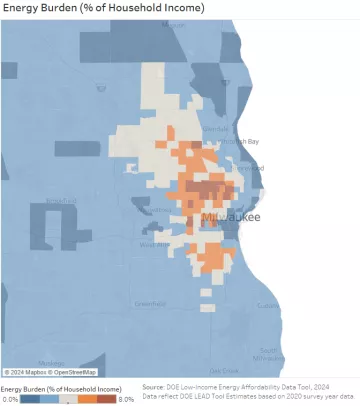After the 2021 study revealed major racial disparities, not much has changed 3 years later.
On Friday, We Energies filed yet another rate increase for its customers, the third increase in three years. Rates will increase approximately $10-11 more per month for residential customers in 2025 and an additional $7-8 more in 2026. In the last two years, We Energies increased its rates more than 13% and continues to propose costly fossil fuel gas projects that will contribute to higher rates and more pollution in the region.
Sierra Club and several other organizations have additionally released its follow-up study on energy burden in Milwaukee, revealing how We Energies’ continued costly fossil fuel projects and rate increases disproportionately harm Black and Hispanic/Latinx neighborhoods, who are experiencing energy burden roughly double that of predominantly white neighborhoods. The original report was published in 2021.
Energy burden = annual energy utility bills ➗ annual household income
“Energy burden” is the percentage of household income that goes toward energy costs. For example: If your household spends $2,000 annually on energy bills, and your annual household income is $20,000, your energy is 10%. High energy burden is considered 6% or more.
Key Findings
- Median energy burden has decreased slightly from 2021 to 2024.
- Majority white neighborhoods: 2.1% (2021) to 1.9% (2024)
- Majority Black neighborhoods: 5.0% (2021) to 4.9% (2024)
- Majority Hispanic/Latinx neighborhoods: 5.3% (2024) to 4.9% (2024)
- Racial disparities in energy burden in Milwaukee still remain among the highest in the nation. Black and Hispanic/Latinx neighborhoods each experience more than 2x the energy burden of white neighborhoods.

- While 16% of Milwaukee’s metro population is Black, 65% of residents of high-burden neighborhoods are Black. 11% of the metro area population is Hispanic or Latinx, but 19% of the population in high-burden neighborhoods is Hispanic/Latinx.
- The Milwaukee metro area’s white population is about two thirds of the total population, but white residents only account for 9% of the population in high-burden neighborhoods.
- Black neighborhoods saw the smallest decrease in median energy burden, while white neighborhoods saw the largest decrease in median energy burden. This indicates that any improvements are disproportionately missing those who need them the most.
- The lowest income customers are worse off. While median energy burden is slightly lower than in the 2021 report, lowest income customers in the region are experiencing significantly higher energy burden now.
- Low income households that fall below 1.5 times the federal poverty level spend as much as 20-26% of their income on energy bills, up from 15-20% in 2021.
- Low income households that fall below 1.5 times the federal poverty level spend as much as 20-26% of their income on energy bills, up from 15-20% in 2021.
- We Energies continues to propose costly fossil fuel projects and rate increases. Over the past two years, We Energies has received more than a 13% rate increase, following a decades-long trend of increasing rates. The utility continues to propose costly fossil gas projects that will contribute to higher rates, result in stranded assets,
and add to air pollution in the region.
View the full report and graphics at https://www.sierraclub.org/sites/default/files/2024-04/EB%20report%20update%202024%20%281%29.pdf